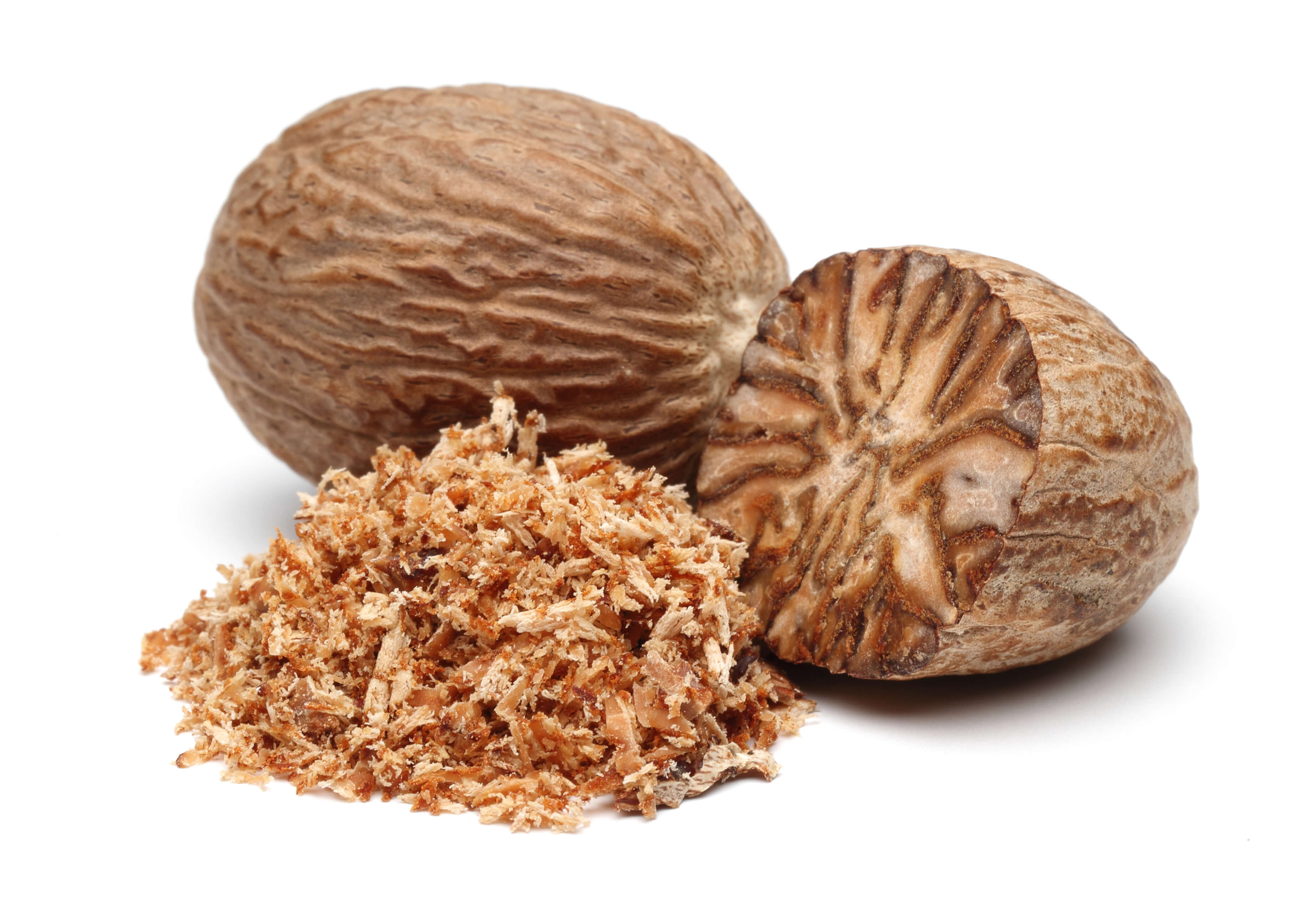Nutmeg EO
Naturelle
Spicy > Cool Spices > Dry Woods > Earthy

Crédits photo: ScenTree SAS
Latin name :
Myristica fragrans
Botanical profile :
The nutmeg tree is a tree of the Myristicaceae family and the genus Myristica.
Geographic origin :
Originally from the Moluccas, an Indonesian archipelago, nutmeg crops are now grown mainly in sub-tropical and tropical Asian areas: Indonesia and Grenada mainly, India, Sri Lanka, China, Zanzibar, Australia.
Chemotypes :
The genus Myristica contains about 150 species. Only sweet nutmeg is used for perfumery.
There are several ''fake nutmegs '':
African nutmeg (Monsmella myristica) from Jamaica, has an essential oil with α-Phellandrene, reminding the smell of nutmeg.
The nutmeg of Guiana (Acrodiclidium camara) from South America.
The Ashenti pepper (Piper guineense), with leaves reminding of the nutmeg smell.
There are several ''fake nutmegs '':
African nutmeg (Monsmella myristica) from Jamaica, has an essential oil with α-Phellandrene, reminding the smell of nutmeg.
The nutmeg of Guiana (Acrodiclidium camara) from South America.
The Ashenti pepper (Piper guineense), with leaves reminding of the nutmeg smell.
Extraction process :
The fruits are harvested all year round with a fruit picker. They are dried in the shade, to avoid melting the lipids. Six to eight weeks later, the seed is separated from its hard shell to be ground and steam distilled.
At the end of the process, the essential oil is collected in the essencier by decantation of the water. This distillation yield oscillates between 8 and 10%. The first harvest should take place seven years after planting the tree, as the fruits ripen slowly. The older the tree, the better its productivity and therefore, the quality of its essential oil. The absolute can be obtained by extraction with volatile solvent, with a spicier and aromatic smell.
At the end of the process, the essential oil is collected in the essencier by decantation of the water. This distillation yield oscillates between 8 and 10%. The first harvest should take place seven years after planting the tree, as the fruits ripen slowly. The older the tree, the better its productivity and therefore, the quality of its essential oil. The absolute can be obtained by extraction with volatile solvent, with a spicier and aromatic smell.
Major Components :
Sabinene (30 - 50%)
Alpha-Pinene (10 - 20%)
Beta-Pinene (10%)
Terpinen-4-ol (7%)
Gamma-Terpinene (3%)
D-Limonene (3%)
Myrcene (3%)
Alpha-Terpinene (2%)
Safrole (1%)
Plotter(s) : Myristicin (2 - 10%)
Alpha-Pinene (10 - 20%)
Beta-Pinene (10%)
Terpinen-4-ol (7%)
Gamma-Terpinene (3%)
D-Limonene (3%)
Myrcene (3%)
Alpha-Terpinene (2%)
Safrole (1%)
Plotter(s) : Myristicin (2 - 10%)
- Uses in perfumery :
- Spicy note modifier. Used in cologne and men's eaux de toilette.
- Other comments :
- The nutmeg fruits are drupes shaped as apricots. At maturity, these drupes open little by little and the seeds appear. At this moment, they are wrapped in a brown shell.
The Nutmeg EO is very photosensitizing and is strongly discouraged for pregnant women.
Nutmeg alone is a narcotic because of its myristicin high content.
Over the last few years, producers of nutmeg EO have been seeking to create qualities without Safrole and Methyl Eugenol, in order to meet the growing demand for an ''allergen free '' essential oil. - Volatility :
- Head/Heart
- Appearance :
- Colorless liquid
- Stability :
- The terpenes identified in this raw material can polymerize when they are oxidized
- Price Range :
- €€€
- Aromatherapy :
Informations provided below are taken from reference works in aromatherapy. They are given for information purposes only and can not constitute medical information, nor engage the responsibility of ScenTree.
Nutmeg is renowned for its analgesic and neurotonic properties and is recommended for body aches, prolonged fatigue and digestive parasitosis.

Crédits photo: ScenTree SAS
- EINECS number :
- 282-013-3
- FEMA number :
- 2792
- Allergens :
- Linalool - D-Limonene - Eugenol
- IFRA :
- This ingredient is restricted by IFRA
- Annexe I :
- Some regulated synthetic ingredients are found in nature and in certain proportions in natural ingredients. This presence in nature has to be taken into account when calculating limits of use recommended by the IFRA. In case you do not know these concentrations, you can use the ones estimated by the IFRA. Here they are :
- Annexe I :
- Some regulated synthetic ingredients are found in nature and in certain proportions in natural ingredients. This presence in nature has to be taken into account when calculating limits of use recommended by the IFRA. In case you do not know these concentrations, you can use the ones estimated by the IFRA. Here they are :
| List of regulated compounds contained in this ingredient | ||
|---|---|---|
| Regulated ingredient name | CAS N° | Estimated Concentration |
| Methyl eugenol | 93-15-2 | 1,2 |
| Safrole | 94-59-7 | 1,5 |
| Eugenol | 97-53-0 | 0,2 |
| Isoeugenol | 97-54-1 | 0,5 |
| List of regulated compounds contained in this ingredient | ||
|---|---|---|
| Regulated ingredient name | CAS N° | Estimated Concentration |
| Methyl eugenol | 93-15-2 | 1,2 |
| Safrole | 94-59-7 | 1,5 |
| Eugenol | 97-53-0 | 0,2 |
| Isoeugenol | 97-54-1 | 0,5 |
To learn more about IFRA's standards : https://ifrafragrance.org/safe-use/library
ScenTree is solely responsible for the information provided here.





